|
|
Review of GSM-handset Samsung X820
Live photos
of Samsung X820>>>
Slim phone fashion was started by Motorola, RAZR’s design was copied
numerous times and some of those products were from Samsung as well.
It’s hard to create something unique and not similar to other products
when you have an example of successful product in front of you.
It’s like in case with a child, when you tell him not to do something,
he does that on purpose.
Initially “slim” line from Samsung was not unique in terms of design,
there wasn’t any success in making thinnest phone possible either,
this was a symmetric answer to RAZR’s success. Such answers were
made by all other companies except for Nokia. But Samsung decided
to go even further by selecting slim products as one of main ways
of developing in 2006, it also managed to create several products
before Motorola did. A sort of hide and seek game between manufacturers.
Someone in Motorola could not control his flow and said that Motorola
is planning to release a 5-6mm thick phone, which means that BLADE
family is not that thin. This idea has been caught by journalists
and successfully disproved by Motorola’s representatives. However
at same time CeBIT’s booth had decoration elements that contained
information about future product, there was a surgeon, who has been
saying something about scalpel, and corresponding abbreviator been
placed. Such contradicting information was caused by fact that company
realized the need not to announce its products before their commercial
launch, or prior release date. Design copying problem became very
actual for Motorola, since no one is using same materials, everyone
creates simplified copies, that require less developing time. But
if we talk about slim series, all information was available at market
in 2005, and Samsung began building its plans.
Fight for “slimmest” phone on the market started in two directions
at once: one was hinted by Motorola – usage of metallic case, which
allows keeping case proof; second – attempt to use traditional materials
in order to achieve case’s slimness. As a result of first direction
we had Samsung P300 – a small handset that reminds of calculator,
similar in size with a credit card, but pretty thick. Model was
interesting due to several solutions including external battery
built into phone’s leather case.

Sticking point for Samsung with usage of metallic parts was lack
of experience of creating such products. A lot of processes have
to be carried together, antennas should be placed correctly, so
that network reception would be good, and so on. It was hard to
do in a small product that was supposed to become mass solution,
all these operations were hard to perform. This is why Samsung P300’s
format became independent, there will be 2-3 models released in
nearest future, they will be different in terms of functionality
(better camera, updated interface, memory card), but there will
be no further miniaturization of these models. These models are
grouped by “Card” tag, this leads to their similarity with creadit
card. Such phones became a tradition of production for NEC.
Metallic case points on fashion segment, sort of exclusiveness
from Samsung, which was proven by Samsung’s P300 sales. This is
not a mass model, but it has pretty good demand for its price, due
to design uniqueness, it attracts consumer’s attention.
Second direction of evolution was usage of traditional plastic,
which was considered impossible for slim handsets. The only natural
limitation is plastic itself, its proof, the thinner it is, the
lesser its bend proof, steadiness against deformations and mechanic
damages. Taking the fact that there had to be a handset chip, display
besides plastic in the case, such mission seemed unreal. However
in Samsung it was considered possible for them, and so two projects
were set up for development – Illusion and Spear. Difference between
these two products is in 2 mm thickness, plus second product is
an UMTS phone and will be released on the market only in autumn.
Meanwhile Illusion model was named Samsung X820. Company had started
giving code names at Russian market in 2006 for commercial products,
for example you can see Samsung E900 posters with Phantom codename
on Tverskaya street in Moscow, as well as P300 with Platinum. As
for X820, code name and internal name collide, model will be called
Illusion. Company is not using code names for any other country
in the world. As for Russia, will of using such code names was motivated
only by aggressive promotion of such solutions by Motorola (RAZR,
SLVR), it seems that Samsung sees a strong competitor in Motorola.


During development process R&D center of Samsung encountered
numerous problems, including the above mentioned fragility when
small thickness is used. Solution was simple and elegant: plastic
was reinforced with glass fiber, which allowed getting 0.7mm thickness
of battery section cover. This means that thickness of plastic is
not more than 1mm, it’s even less. Each user of Samsung X820 can
easily see how easily battery section cover can be bend into every
direction when held in one’s hands.
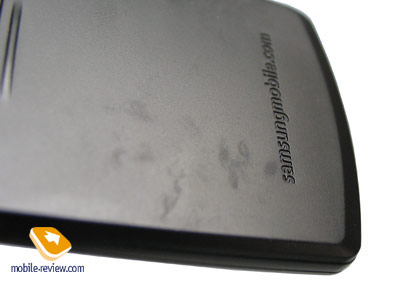


Video
clip, comparing size and battery section cover (wmv, 1.35mb)>>>
Engineers of several companies did not believe into possibility
of creating such phone from plastic, but once they saw Samsung X820
sample, they had great respect for the work done in R&D center
of company. Samsung came a long way to create such plastic. In case
someone is not considering this being worth attention, than this
person is not understanding deepness of goals that manufacturer
had to face.
Plastic thickness is not the only way to make case thinner, we
can also mention element placement on handset chip, their protection.
Display is traditionally most unprotected place in the handset,
that’s why we can see protective edging made of metal, improved
by plastic covers and solutions of same kind. In case with this
model, manufacturer decided to limit protection by installing protective
glass made of hard plastic and strengthening frame.

Handset has strengthened frame, this means that plastic in construction
and its thickness are maximal. Edging is also strengthened by plastic,
but it has less thickness. Manufacturers used another know-how:
they made case movable, able to bend under load. In case you take
handset in your hands and try to bend it, you will see that it has
slight liveliness (about 1-1.5mm) right at the turn of battery section.
Construction was indeed created in order phone to have slight liveliness,
even board on which all elements are fixed was specially designed
to match this factor. Phone’s flexibility does not provide absolute
protection from breakage, but it guarantees that phone will not
crash into small pieces in back pocket of your jeans, when you sit
on a chair or armchair. I was performing this operation more than
once, and did not feel any difficulties. Handset is not sensed when
it is in your back pocket, as well as others to be honest, you somehow
forget about it and eventually you start looking for one brokenly.
This is other side of the miniaturization medal.

Manufacturer claims that phone’s dimensions are 113x50x6.9 mm,
but this is not true. Whole world uses system according to which
case thickness is measured by most thick part of one, and inc ase
with X820 this is related to camera module, which is almost one
centimeter thick (9.8 mm). Module itself is around 1.5 centimeters
high, which is slightly more than 10% of overall handset height.
This module does not affect perception of a slim handset, it fits
overall appearance nicely. It is interesting how company is planning
to react on maximal thickness issue with camera, will there be a
corresponding footnote, or handset will simply be named as “world’s
slimmest handset” without any confirmation.
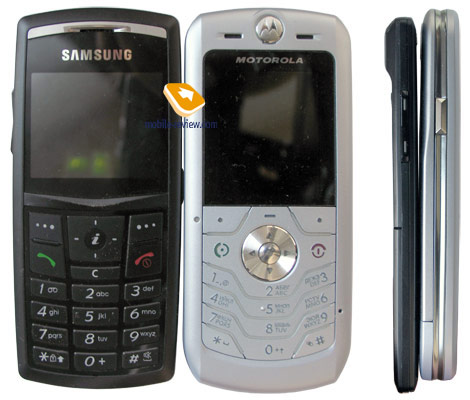

Camera issue was a serious problem, since placing a 2mpx camera
module into handset which is around 7mm thick is impossible (module
itself takes this much space, and it needs to be placed inside the
case). Motorola was trying to achieve smooth surface when designing
its slim products, they did not plan to bear-out camera module.
In case with Samsung it was decided that besides case thickness,
overall functionality is important as well, good 2mpx camera will
be a big support in this case. In my opinion company’s courage to
combine different solutions is making this product highlighted,
different from others, this is an interesting move and it will allow
achieving good results.

Samsung X820 usage experience for couple of months shows that this
model is certainly providing the so called WOW-effect. Handset’s
diminutiveness. Its thickness do not leave anyone indifferent. Girls,
once they see the model, start inquiring weather there are other
color solutions. At the moment there is only black color edition,
but there will be other colors available with time – blue or sea-green,
gold, pink. Last two solutions are rather pale, not saturated with
color enough, and they don’t look stunning in my opinion. Sea-green
color at same time is very much similar to Motorola’s solutions
that will be released by end of this year – this is SCPL, as well
as clamshells and slider of “slim” series. Only case material is
different, in case with Motorola’s products its ceramics with color
play, lighting acting on surfaces.
Protective glass used for display gets soiled easily. This is visible,
on the other hand only during bright lighting conditions, and you
are not likely to see this indoors. There is a silver insertion
made of plastic above the screen, this is one of the few elements
that stand out of overall color scheme.

Display orientation is horizontal (album), it is similar to one
in Samsung P300. Display is common for next to last generation of
handsets for Samsung, it has 220x176 pixel resolution (35x28 mm,
1.9 inches). There can be up to 5 text lines placed on the display
and up to three lines for service needs. Texts are pretty much comfortable
to read in album orientation. Display is capable of showing up to
262000 colors, picture looks saturated, it is clearly visible in
different conditions, including bright sunlight (TFT). Picture quality
is actually one of the best in its class. And as for “slim” handsets
– it is the best, which deserves separate praising. In case with
all other solutions display is a compromise settlement, and is not
that as good as in X820.


Those who love showing off its handset to others by hanging it
on their neck will be disappointed to find out that there is no
such possibility in case with Samsung X820. Company did not include
hole for strap, although this was possible to do in camera module
location. This was more of a principled decision, just like in case
with Samsung P300, handset has to be carried in a pocket, so that
you will feel pleasure from using it.
Bulk of handset due to plastic usage is not that big at all, it
is only 63 grams. Manufacturer however claims that it is 66 grams,
but we got used to rely on our electronic scales, than on official
statements.
Numeric keypad is original and is a prototype of what we will see
in slim solutions from Samsung in 2006-2007. I’d like to make a
note that there will be a certain division of product line-ups by
keypad: several models will receive sensor keys (not all, of course
this will be a combo of common and sensor buttons), others will
have common ones.


Keys are made of plastic, they do not stand out much, but due to
big size, they are comfortable to work with, all of them except
for navigation key, its size is slightly less than one being characterized
as comfortable one. Backlight color is white, it is equally spread,
not very bright, but is clearly visible in all conditions. Keys
do not get pressed accidentally when handset is located, but it
is better to use keypad lock. When compared to standard handset,
this one has less stray keystrokes.

There is joined volume adjusted button on the left side, and camera
button as well as headset and charger connector on the right. Jack
is covered with plastic cover attached to case.

Battery section cover is snapped pretty much surely, but with time
its fixation can feeble. This means that by carrying out handset
from your pocket you can remove the cover, there will be a small
hole. Sometimes cover can even fall down, I’ve encountered this
two times. I’d like to make a note that weather this fact can be
assigned to trouble list or no depends only on your opinion on the
matter. For me personally this is no way of a stumbling block, it
does not ruin overall impression of handset, it is clear that with
such thickness of cover it is impossible to achieve proof fixation
for all situation. In most cases battery cover is surely fixed,
this is pretty much enough.
Battery is well matched with handset’s size, although it looks
pretty common. It lost a little bit of capacity when compared to
standard handsets, where it is usually 800 mAh. Here we have LiIon
battery with 630 mAh capacity. Manufacturer states that battery
is able to provide up to 210 hours of stand by mode and around 2.5
hours for phone calls. Handset worked for about 2-3 days in Europe,
with 1 hour spent for phone calls and only alarm clock was used
besides that. At same time battery lasted for about 2 days in Moscow,
with 1.5 hours of phone calls. Here is where we can draw the conclusion
that this model will work for minimum 2 days with average load,
but 3 days can be achieved as well (minimal load). Full charge time
for empty battery is 1.5 hours. Due to overall case thickness there
is no improved capacity battery edition support for this model.



This handset provides one of best performances in terms of battery
life in its class. As for shortcomings, manufacturer forgot to redo
battery level meter algorithm, or did a poor job on that. First
day handset is showing full battery, with its usage for 1 position
(three of three) around 50-60 percent of real battery life are spent.
Remaining 40% expire very fast. This is why you can trust battery
meter only in case you remember that one or two positions mean that
you should charge up your handset. Usage of plastic provided positive
influence on the model, unlike P300, where energy consumption was
higher not in the last reason because of metal used in the construction.
Menu
Handset is built on same platform as other models from Gumi, and
we could have easily closed our eyes and ignore small modifications
that were introduced, but this way we would miss the chance to tell
you about all small interface improvements, which make our life
varied and make this model more comfortable.
Company realized that interface has to be redesigned well in order
to fit handset’s outlook, this model is one of the first with such
interface realization. Skins that were introduced in previous models
do not just change window titles, but whole appearance of menu.
There are two skins in handset – black and white (black is set by
default). This is why interface looks extremely interesting, both
editions are nice.


Main menu is presented in shape of 3x3 matrix, icons are animated,
and highlighted menu item gets its icon scaled. Fast numeric key
navigation is present. All sub-menu items are presented as vertical
lists. Navigation key can be assigned with shortcuts to access most
used functions.
Video
clip demonstrates handset’s menu (wmv, 2.21mb)>>>


Another interface modification is item’s highlight in vertical
lists, you will see that font gets increased in size. Once you enter
Settings menu or any other, you will see highlighted item that you
checked last time. For example in case you picked Email in Messages
folder, you will see it being highlighted next time you access this
folder. We will speak about other improvements as we go on describing
interface.
Phone book. Contacts can be accessed by pressing
right soft key, you will see a list that contains all entries from
both SIM-card and phone’s memory. By default first name is highlighted,
and you will see phone number in service text line (SIM-card entries
are displayed with corresponding icon). Fast name search by first
letters is supported, there can be up to twenty of those, for any
language. Once you press OK key you will go into detailed view of
selected entry. Here you will see a thumbnail in case there had
been one assigned. It can be either an image or a photo. Each entry
can have up to 5 contacts of different types (cellular, office,
home, fax other), one of them will be main one (by default it is
the first one that you enter). Fields are fixed.

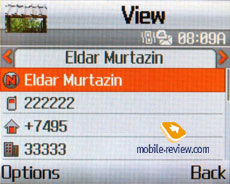




There are two lines for name and surname (search is made only by
first field), fields get summed when displayed, first comes the
Name. For example Eldar Murtazin will be shown in this sequence.
On other hand names can be sorted manually by surname, list will
be refreshed dynamically. Length of each field is 20 characters,
for any input language. You can also switch languages when entering
a name.
All entries, without regard to language, are sorted out under the
algorithm – all contacts with headings made in a local language
(Russian, for example) go first and then those with names in English.
This is rather convenient and handy list sorting system. Taking
into account fast language switch option during the search, it’s
clear that no language will spoil the experience of working with
this phone.
But let us return to the information entered for a contact. Apart
from phone numbers, e-mail address (there may be a number of them),
a little text memo can be submitted on top of all that. Any music
file as well as composed MP3's can be picked as a ring tone for
a contact. Three caller groups are provided by default with the
possibility for creating any number of additional groups, selecting
a personal melody and image for each.
The phonebook is capable of holding up to 1000 contacts with filled
in data fields. Even if all the available blanks are not used, the
cap won’t get any bigger and will still make one thousand. It is
possible to set in the settings where all new numbers should be
kept by default. There is also an option for moving entries from
the SIM-card although the vice versa action is denied. According
to the developers, PC is the best means of synchronization, MS Outlook
in particular. Any contact in the form of SMS/MMS, mail message
or other text file can be sent quickly through Bluetooth to another
device. There are no problems with sending and the phone book entry
being transmitted to another device is precisely decoded without
any trouble.
The phonebook may contain a business card as well, though its structure
copies all the fields applied to a regular contact in the phone
book.
There can be up to eight numbers in the fast dial list; separate
numbers tied up with a single contact may appear on this list as
well. The subtitle of the chosen entry (but not of the phone number
type) is displayed on the buttons.

When receiving a call, a picture occupies not the entire screen,
but only a part of it, however it still takes up a considerable
area.

Call lists. Each of the given lists contains up
to 30 phone numbers. There is a combined list of all the last calls
with an icon indicating a call type. Declining the navi-pad horizontally,
you can switch quickly from one list to another. The date and the
time of a call without special note of duration are displayed in
extended view for separate entries. Calls from/to one number are
summarized, so that a number standing next to the call specifies
total amount of calls made. In order to access duration data you
will need to call up detailed information on desired item. As always,
the overall time of the calls and their prices can be viewed in
this menu (in case the service has been enabled).
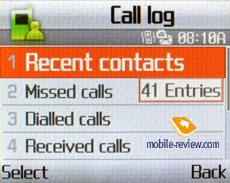


Messages. Working with various types of messages
is implemented through separate submenus. Let us begin with short
messages. The phone memory can hold up to 200 messages simultaneously;
the handset supports EMS standard compatible with Nokia Smart Messaging.
T9 text input capability comes in handy and is easy to use. When
at choosing recipient window, you can either select a telephone
number from your contacts or pick one from the call lists or groups.
All messages are manageable, this means you are at liberty to move
a certain number to your black list, in order to make sure all messages
coming from that phone number will be deleted automatically; possibility
for moving messages to any own folder is also at your disposal.









MMS. The interface for multimedia messages looks quite
good; the messages can be saved in several folders right away after
receiving or drawing them up. There are no size restrictions on
received messages, though an outgoing message’s size is limited
295 KB. As for additional services available with the X820, advertising
messages rejection and message receiving type options are onboard.
Unlike all other models, all messages are located in a separated
storage area, which takes up 3.7 Mb and contains eMails on top of
standard messages.




The bundled mail client is standard in all its components – 5 accounts
and the maximum of 100 incoming messages; attachments are also handled
by the phone, though there are also several caps – there’s no way
you can receive a file more than 5 Mb in size, or send one with
size exceeding 300 kb.


Organizer. There can be up to 400 different events
of four types (4x100) - meeting, affair, anniversary and others.
The day and the time as well as end time of the even are indicated
for each entry. Alert signal, as well as its duration can be adjusted
according to your liking; repeatable events are available for setting
up (at that repetition time is also adjustable as well as exclusion
dates). The weekly and the monthly calendar are very convenient
with each type of the event having its own color.




Tasks – a standard list of tasks with the possibility
of stating priority. Maximum capacity of this section is 20 entries.
WAP. There is a wap-browser ver. 2.0, similar
to that carried by some phones by Nokia and Sony Ericsson, using
http protocol. The browser automatically offers you standard prefixes
and endings of the entered addresses. Although it’s feature-packed,
it would make more sense if you replace it with Opera Mini.


Applications. MP3 player. An integrated
mp3 player, supporting random track playback, sequential and cyclic,
is available on the phone. Mp3 files can be uploaded to the phone
both directly through Bluetooth and through a synchronization application.
There no limitations, placed on tags and names of music files. The
user is armed with nearly 80 Mb of storage available for filling
up with music and other apps and content




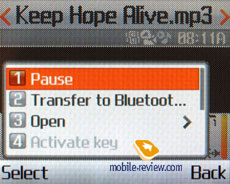



The title of the track playing is displayed as well as the number
of the remaining tracks. The equalizer doesn’t make much sense,
as there is no precise adjustment of audio controls (only a possibility
to choose from classic, rock, jazz and normal sounding). The tracks
can be played through the stereo headset as well as through the
speakerphone. The volume bar has 10 scales on it. And of course
user can make up playlists of his own with the X820.
Dictaphone. You can record up to several hours of voice
memos with the number of files being unlimited. Basically, limitations
on recording durations are set by user himself, though length of
a single recording cannot exceed 1 hour. All the files are stored
in a separate folder in the memory bank. The recorder performs well
during lectures, conferences and presentations – I could even say
that it is a partial substitute for a digital tape recorder.
Java World. The phone has only 2 pre-installed games on-board
– these are BobbyCarrot, and FreeKick. Downloading of new applications
and games is carried out only via wireless networks, at that size
of a single JAR file cannot exceed the limit of 1 Mb. The size memory
bank reserved for Java-applications is 4 Mb.





World time is displayed for two chosen cities.

Alarm clock. The phone is equipped with three alarm clocks.
One is meant for mornings and can be set for selected weekdays as
well as for weekends. For each of the alarm clocks there is a selection
of five tunes, though necessity of them is questionable, as mp3
tracks can be used there as well. It is up to user to set up whether
the phone will turn on automatically in the time of the event or
not.


Calculator. It divides, multiplies, subtracts and adds
and does several more things – quite enough for a mobile calculator.

With a converter, you can operate with different units
of measurements as well as with a number of currencies.

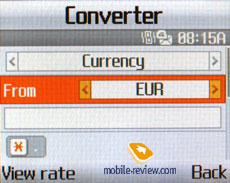
Image editor. A basic picture editor, which allows transforming
images by using a variety tools.


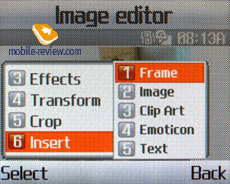
File Manager. That’s the place to search for all
files such as music, pictures, video and sounds. Any uploaded file
gets stored here. The disadvantage is that files sometimes are not
displayed in the list immediately - in that case you will need to
leave the menu and enter it again.

Settings. This item boasts a standard set of options
inside - font color in the standby mode, password protection of
selected sections (messages, short messages, organizer, etc.), backlighting
duration and brightness, dialing numbers (a fetching function, which
has been incorporated only in a couple of models by Samsung so far).








Bluetooth. The handset supports various profiles,
namely, Headset, Handsfree, Serial Port, Dial Up Networking, File
Transfer, Object Push, and A/V Headset. The Bluetooth realization
is not ideal, troubles with headsets having only a Headset profile
appear pretty often, and work with the speakerphone is incorrect
sometimes either. In general the Bluetooth found on the X820 is
better than that on Nokia’s phones, Siemens, but worse than on Sony
Ericsson.

Camera. Samsung retains the same 2 Mpix CMOS camera
as the D600. The camera interface is standard for the company’s
products - you can rotate an image vertically, turn off the shutter
sound. Image compression quality is adjusted from the menu - Super
Fine, Fine, Normal, Low. The ISO value may vary from 100 to 1600,
but the default value is handier. White balance has several levels,
and Auto is set by default.





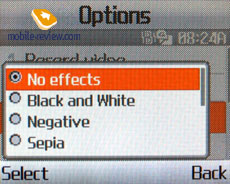
Image taken in maximal resolution gets processed in 2 seconds (1600x1200
pixels). The handset’s camera can boast neither auto-focus nor macro
mode. Considering the camera quality, it would be better to take
snaps only in sunny weather; when shooting against the sun, the
camera focuses on the brightest spots of the image. Exposition determining
system does its best when the objects have contrasting parts – e.g.
posters. The model equals to Nokia N70 in terms of image quality,
as hardware specifications of both devices coincide. At the same
time, the photos taken by these handsets are worse than those by
Sony Ericsson K750 or Nokia N90.
The device supports such effects as Gray scale, Negative, Sepia,
Emboss, Sketch, Antique, Moonlight, Fog.
 |
 |
(+)
maximize, 1600x1200 |
(+)
maximize, 1600x1200 |
 |
 |
(+)
maximize, 1600x1200 |
(+)
maximize, 1600x1200 |
 |
 |
(+)
maximize, 1600x1200 |
(+)
maximize, 1600x1200 |
 |
 |
(+)
maximize, 1600x1200 |
(+)
maximize, 1600x1200 |
 |
 |
(+)
maximize, 1600x1200 |
(+)
maximize, 1600x1200 |
 |
 |
(+)
maximize, 1600x1200 |
(+)
maximize, 1600x1200 |
 |
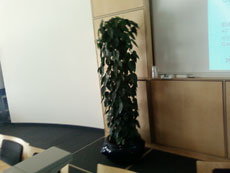 |
(+)
maximize, 1600x1200 |
(+)
maximize, 1600x1200 |
Also there is a possibility to take 6, 9 or 15 photos in a series;
you can set two types of speed for each case (normal and high).
Finally, the device supports matrix photos (2x2, 3x3).
The photos are kept in the album, where you may view the data on
a certain photo (not above the photo as in previous models). The
list itself features the handset’s name a thumbnail next to it.
Any photo may be assigned to a name in the phone book or set as
wallpaper right from the album menu. There are also a slide show
mode, a basic editor that allows adding emotion icons, applying
frames and effects to the photos.
The phone records 3GP video and you may choose whether it will
be recorded with or without sound. All the settings are comparable
with those for photos, the same 4-graded quality bar, but the resolutions
are different. The maximum resolution is 355x288 pixels.
There is no limit on the duration of the record – it’s more about
how much storage you have available. Though when speaking about
MMS mode, the videos do have cap, which makes 100 Kb
Video
sample 1 (mp4, 2.21 Mb)>>>
Video
sample 2 (mp4, 2.71 Mb)>>>
Video
sample 3 (mp4, 703 Mb)>>>
Video
sample 4 (mp4, 2.18 Mb)>>>
Video
sample 5 (mp4, 546 Mb)>>>
Synchronization with PC. Synchronization may be
carried out via Bluetooth or a cable. Easy Studio 3.0 is located
on the manufacturer's site.
Performance. The device demonstrates moderate
performance, however all Samsung’s solutions possess nearly the
same rates.
Jbenchmark 1
Version 1.1.1
Total Score: 1781
Details:
Text 518
2D Shapes 429
3D Shapes 301
Fill Rate 184
Animation 349
Jbenchmark 2
Version 2.1.1
Total Score: 134
Details:
Image Manipulation 109
Text 200
Sprites 121
3D Transform 139
User Interface 116
Jbenchmark 3D
Perfomance
Jbenchmark3D HQ: 87
Jbenchmark3D LQ: 132
Triangles ps: 10792
kTexes ps: 722
version: 3.1.0
Impressions
As for receiving part, the handset does fine, though it would be
strange to find out something different considering current connectivity
level of all released mobile phones. The sound provided by the loudspeaker
is pure and lacks foreign noises. The 64-tone polyphony is average
volume-wise, while mp3 tunes have enough of sounding to make you
hear them even on the busiest street. The silent alarm is modest
in terms of strength, however one couldn’t have expected more from
such portable device.





Since the X820 is extremely slim, it retains the same flaw, peculiar
to all handsets being 7-8 mm thick – in fact, all these devices
tend to heat up very fast. Motorola has managed to avoid negative
consequences by applying metallic parts in its handsets, but other
phones, like the VK2020 exposes this shortcoming in full measure.
At short calls it’s not so evident, though should you prolong the
conversation to 5 minutes and more, your fingers will definitely
feel how the phone has gotten warm.
The device draws attention firstly because Samsung has managed
to beat the trendsetter on the slim phones market, Motorola. Having
released its own super-thin handset (though cheating at measuring
its thickness) six months before Motorola’s product, Samsung has
made a claim not only for the leadership for the time being, but
for good sale rates and positive image as well. Model SCPL stands
out owing to better materials used, even thickness along the entire
casing, but yields in terms of camera quality. On top of that it’s
release is scheduled for this winter, in other words there is a
whole lot of time for Samsung X820 to gain popularity, top the charts
and fall down; thus these two models can’t be called direct rivals
even.
There aren’t so many slim handsets on the market boasting a candy-bar
shaped casing. The handsets by VK don’t incorporate camera, this
concept-wise they have a common ground with the Samsung’s products.
And on the other hand, while the SLVR by Motorola is not that thin,
it still shows off excellent materials. Therefore it’s possible
to substitute personal design feelings for specification lists,
in other words it comes down to a binary choice “like it – hate
it”
The X820 has already hit the shelves of retail chains at the price
of 525 USD, though its price it reducing dramatically and by the
end of July it is more likely to cost you less than 420 USD. It
may seem strange why the X820 has gotten such poor spreading over
the market; however there is sensible reason, explaining the whole
situation on the Russian market – Samsung has signed exclusive contract
for distribution of this model with Svyaznoy, thus the X820 is quite
unpopular with both other retailers and consumers. On top of that
the company itself has not yet expressed any interest in the model’s
promotion – the model has received only a pinch of advertising in
contrast to less innovative models with average functionality. In
this case, Samsung has outwitted itself and instead of coming up
with a bestseller in its sleeve ended up with fairly good sale rates
in Svyaznoy only. At that the retailer himself doesn’t make attempts
to boost the sales of the X820 and rather prefers advising other
models. Nevertheless it’s the manufacturer which decides the fate
of each model - there are several propositions on the market, which
could have become mass products, but due to being granted to a single
retailer will never hit top of the charts. Summer has always been
the time of freedom of experiments for Samsung, and seemingly this
one isn’t an exception.
Even though the handset looks appealing, similarly to any image
product, it requires the consumers to be aware of it – firstly,
not a single sane customer would buy a slim phone for 500 USD without
being absolutely sure that he is going to be recognized, should
he has this “cool” phone in his hands. However it’s easily achievable
with the help of a well-set advertising campaign – but in terms
of functionality and reliability it will still remain a dark horse
until middle-end of August.
Eldar Murtazin (eldar@mobile-review.com)
Translated by Alexandr "Lexx" Zavoloka
(alexander.zavoloka@mobile-review.com),
Oleg Kononosov (oleg.kononosov@mobile-review.com)
Published — 20 July 2006
Have something to add?! Write us... eldar@mobile-review.com
|
News:
[ 31-07 16:21 ]Sir Jony Ive: Apple Isn't In It For The Money
[ 31-07 13:34 ]Video: Nokia Designer Interviews
[ 31-07 13:10 ]RIM To Layoff 3,000 More Employees
[ 30-07 20:59 ]Video: iPhone 5 Housing Shown Off
[ 30-07 19:12 ]Android Fortunes Decline In U.S.
[ 25-07 16:18 ]Why Apple Is Suing Samsung?
[ 25-07 15:53 ]A Few Choice Quotes About Apple ... By Samsung
[ 23-07 20:25 ]Russian iOS Hacker Calls It A Day
[ 23-07 17:40 ]Video: It's Still Not Out, But Galaxy Note 10.1 Gets An Ad
[ 19-07 19:10 ]Another Loss For Nokia: $1 Billion Down In Q2
[ 19-07 17:22 ]British Judge Orders Apple To Run Ads Saying Samsung Did Not Copy Them
[ 19-07 16:57 ]iPhone 5 To Feature Nano-SIM Cards
[ 18-07 14:20 ]What The iPad Could Have Looked Like ...
[ 18-07 13:25 ]App Store Hack Is Still Going Strong Despite Apple's Best Efforts
[ 13-07 12:34 ]Infographic: The (Hypothetical) Sale Of RIM
[ 13-07 11:10 ]Video: iPhone Hacker Makes In-App Purchases Free
[ 12-07 19:50 ]iPhone 5 Images Leak Again
[ 12-07 17:51 ]Android Takes 50%+ Of U.S. And Europe
[ 11-07 16:02 ]Apple Involved In 60% Of Patent Suits
[ 11-07 13:14 ]Video: Kindle Fire Gets A Jelly Bean
Subscribe
|
















































































































